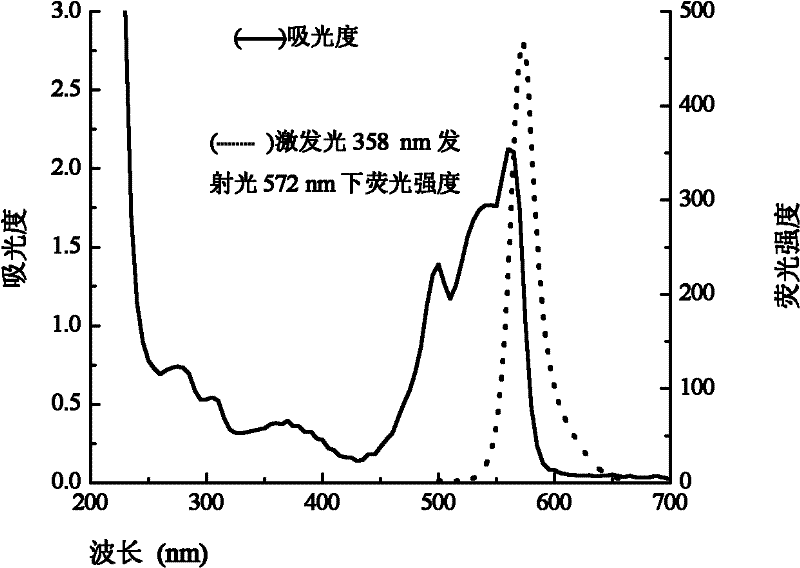Method for separating and purifying phycoerythrin from bangia fusco-purpurea
A technology for separation and purification of phycoerythrin, applied in peptide preparation methods, chemical instruments and methods, organic chemistry, etc., can solve the problems of cumbersome separation and purification process, complicated operation, and high cost, so as to save sample loading time and simplify purification Steps, the effect of accelerating the desalination speed
- Summary
- Abstract
- Description
- Claims
- Application Information
AI Technical Summary
Problems solved by technology
Method used
Image
Examples
Embodiment 1
[0019] 1. Extraction: take 100mL of distilled water to swell 5g of red hair algae powder, after freezing and thawing, add 200mL of distilled water for stirring, mash the tissue, ultrasonically crush, then filter and centrifuge, and collect about 300mL of the supernatant, which is the crude phycoerythrin Extraction.
[0020] 2. Salting out: Add 58.20 g of solid ammonium sulfate to 300 mL of crude extract to make the solution reach 35% saturation of ammonium sulfate, let it stand for 2 hours, and centrifuge to discard the precipitate. Add 29.14g of ammonium sulfate to the supernatant to 50% saturation, let it stand for 2 hours, discard the supernatant after centrifugation, and dissolve the precipitate with 0.02mol / L phosphate buffer (pH=7.0), the volume is about 100mL. Further use the 30kDa molecular weight cut-off ultrafiltration membrane to concentrate and desalt and remove impurity proteins with a molecular weight less than 30kDa. During the concentration process, appropriat...
Embodiment 2
[0026] 1. Extraction: Take 200mL of distilled water to swell 10g of red hair algae powder, after freezing and thawing, add 550mL of distilled water for stirring, mash the tissue, ultrasonically crush, then filter and centrifuge, and collect about 750mL of the supernatant, which is the crude phycoerythrin Extraction.
[0027] 2. Salting out: Add 145.50 g of solid ammonium sulfate to 750 mL of the crude extract to make the solution reach 35% saturation of ammonium sulfate, let it stand for 2 hours, discard the precipitate after centrifugation, and add 71.78 g of ammonium sulfate to the supernatant to 50 % saturation, let it stand for 2 hours, discard the supernatant after centrifugation, and dissolve the precipitate with 0.02mol / L phosphate buffer (pH=7.0) to obtain a salting-out solution with a volume of about 180mL. Further use the 30kDa molecular weight cut-off ultrafiltration membrane to concentrate and desalt and remove impurity proteins with a molecular weight less than 30...
Embodiment 3
[0032] 1. Extraction: take 500mL of distilled water to swell 20g of red hair algae powder, after freezing and thawing, add 1000mL of distilled water to fully stir, mash the tissue, ultrasonically crush, then filter and centrifuge, and collect about 1500mL of the supernatant, which is phycoerythrin crude extract.
[0033] 2. Salting out: Add 291g of solid ammonium sulfate to 1500mL crude extract to make the solution reach 35% saturation. After standing for 2 hours, centrifuge at 8000g to discard the precipitate, and add 143.56g of ammonium sulfate to the supernatant to 50% saturation After centrifugation, the supernatant was discarded, and the precipitate was dissolved with 0.02mol / L phosphate buffer (pH=7.0) to obtain a crude phycoerythrin salting-out solution with a volume of about 260mL. Further use the 30kDa molecular weight cut-off ultrafiltration membrane to concentrate and desalt and remove impurity proteins with a molecular weight less than 30kDa. During the concentrat...
PUM
| Property | Measurement | Unit |
|---|---|---|
| Yield | aaaaa | aaaaa |
| Relative molecular mass | aaaaa | aaaaa |
| Relative molecular mass | aaaaa | aaaaa |
Abstract
Description
Claims
Application Information
 Login to View More
Login to View More - R&D
- Intellectual Property
- Life Sciences
- Materials
- Tech Scout
- Unparalleled Data Quality
- Higher Quality Content
- 60% Fewer Hallucinations
Browse by: Latest US Patents, China's latest patents, Technical Efficacy Thesaurus, Application Domain, Technology Topic, Popular Technical Reports.
© 2025 PatSnap. All rights reserved.Legal|Privacy policy|Modern Slavery Act Transparency Statement|Sitemap|About US| Contact US: help@patsnap.com


